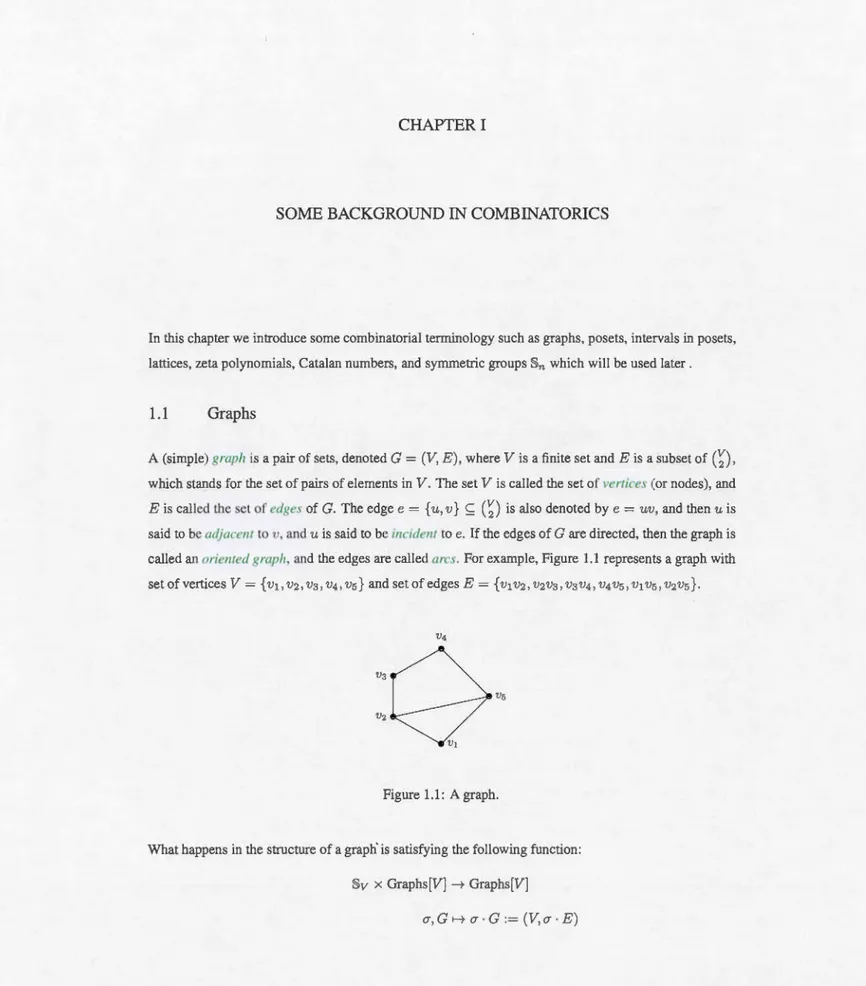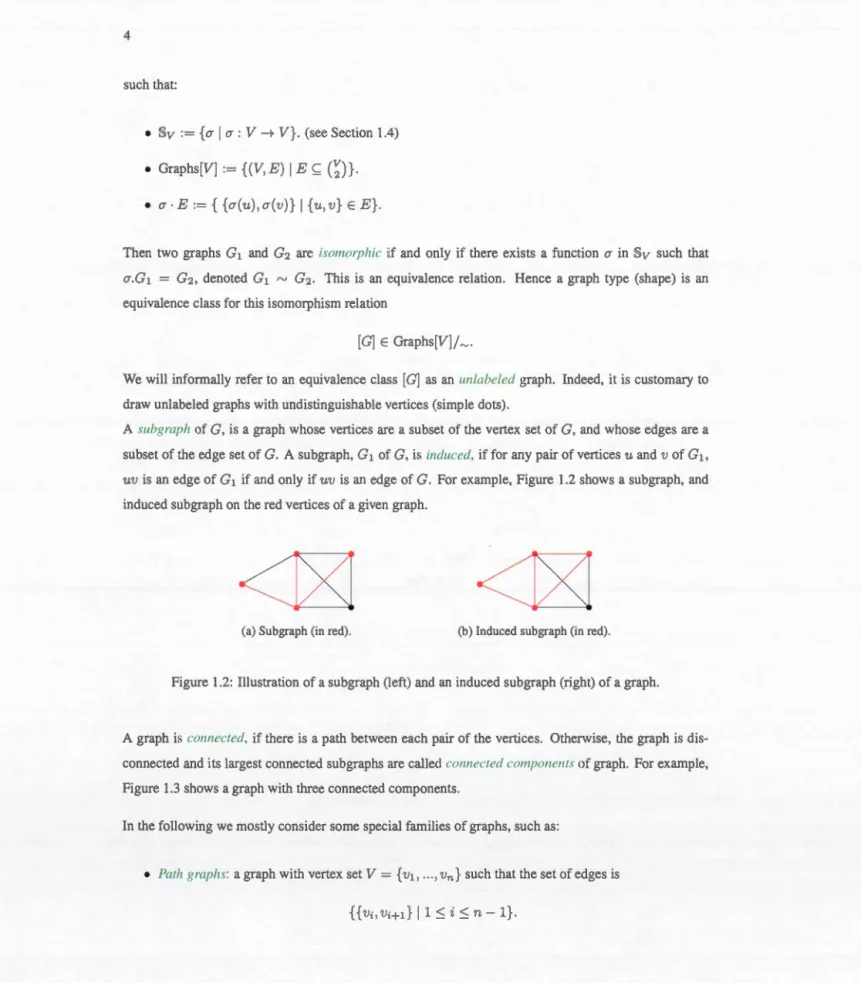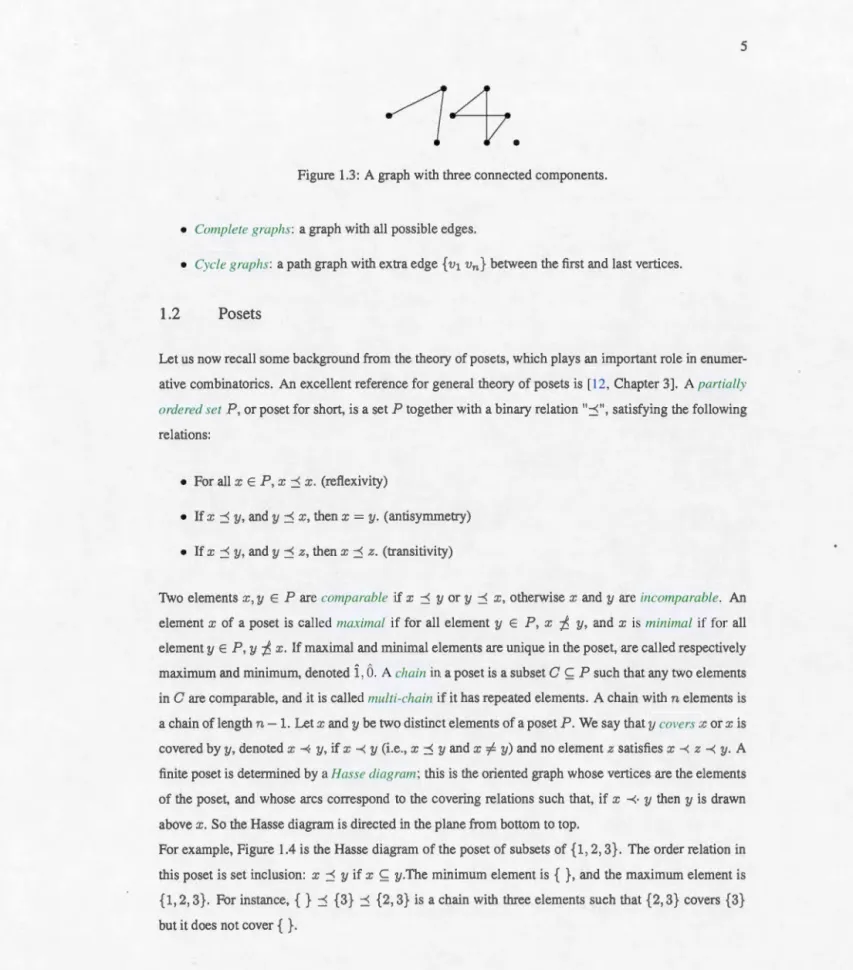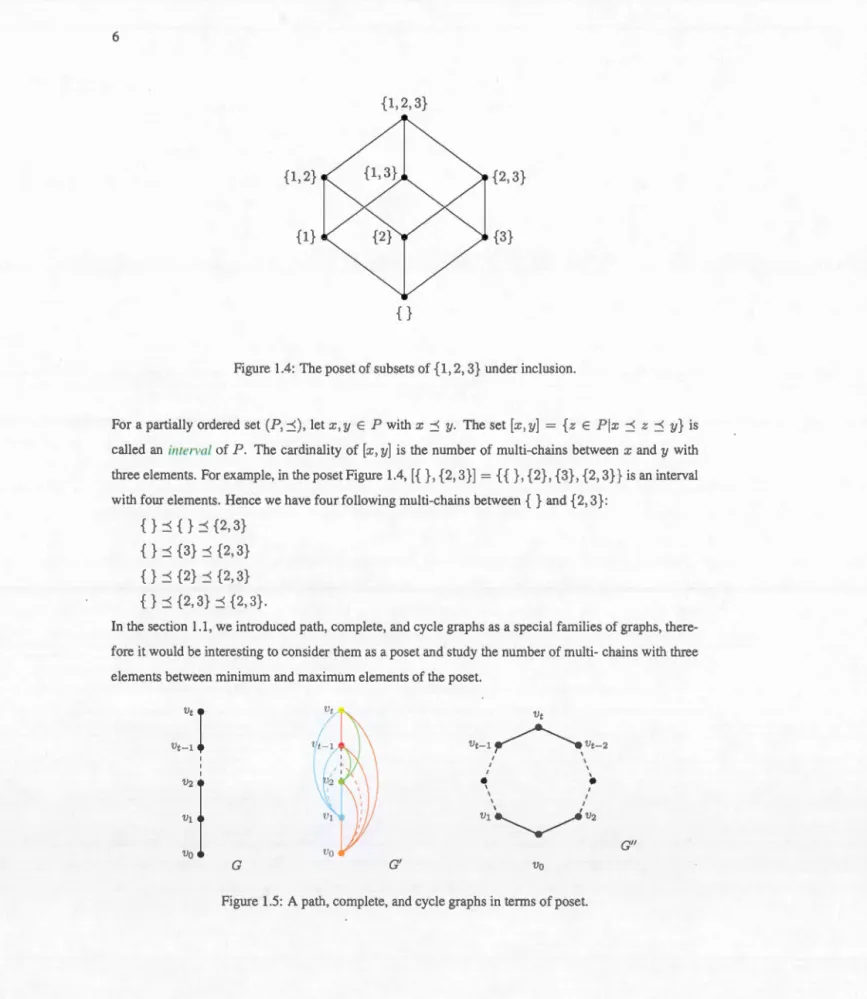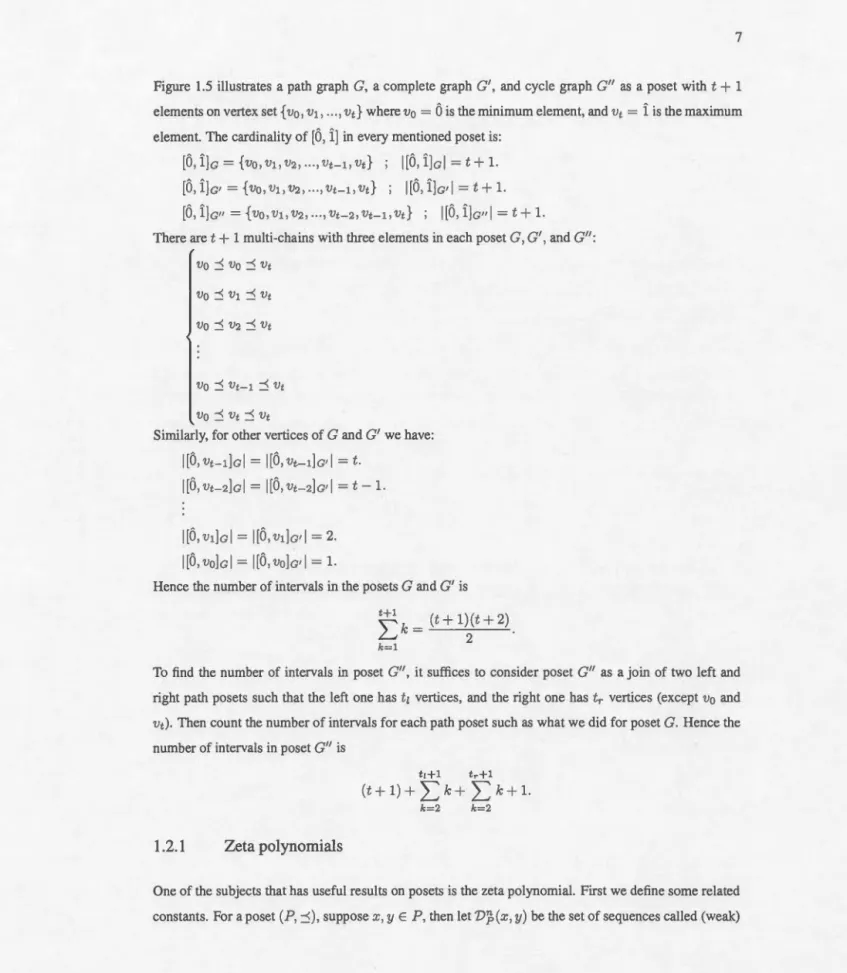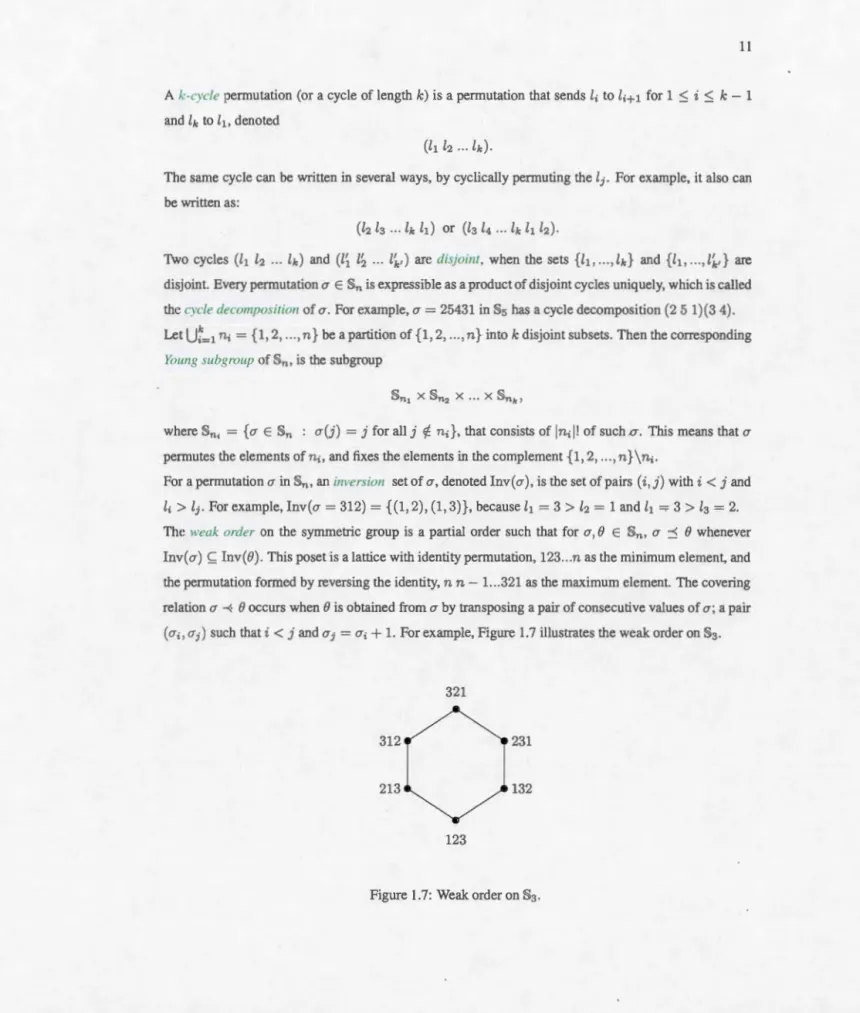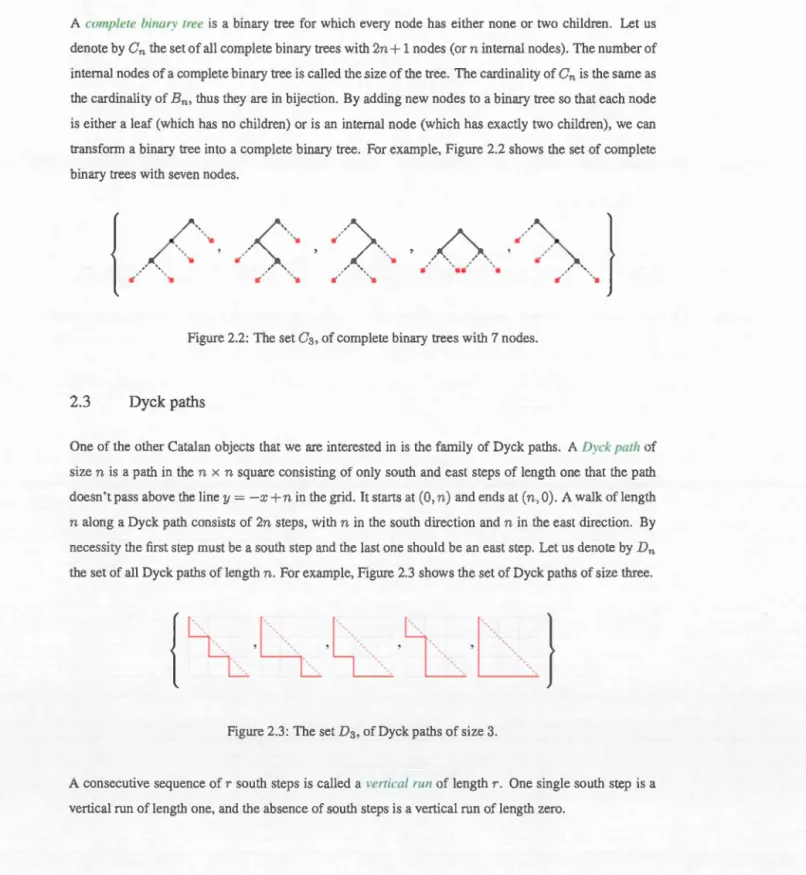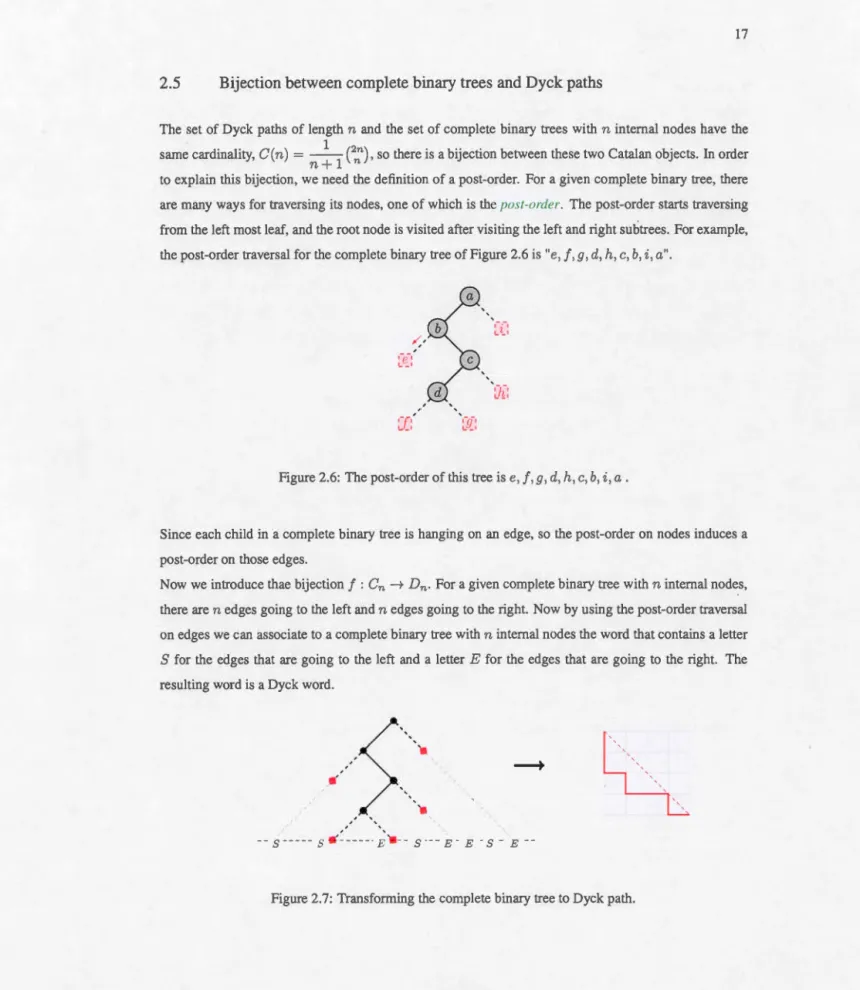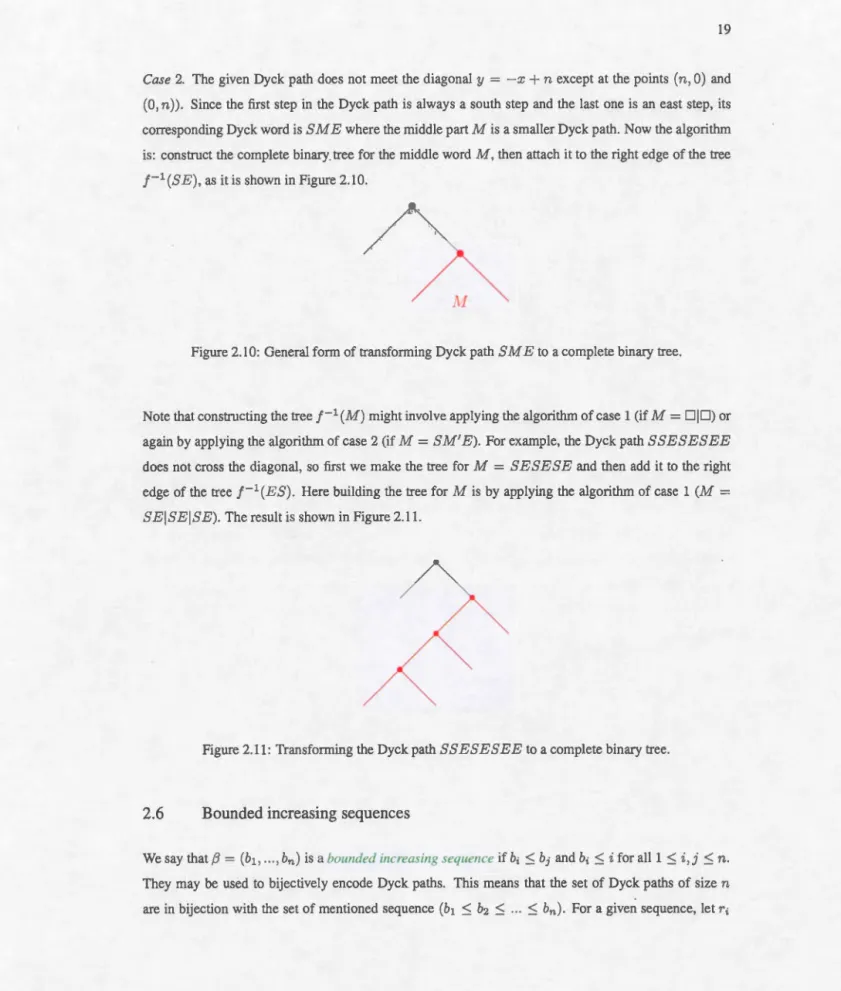- - -
-UNIVERSITÉ DU QUÉBEC À MONTRÉAL
GENERALIZATION OF CATALAN COMBINATORICS TO THE CONTEXT OF
GRAPHS
THE SIS
PRESENTED
IN PARTIAL FULFILLMENT
OF THE MASTER'
S DEGREE IN MATHEMATICS
BY
MARJAN RASHTCHI
UNIVERSITÉ DU QUÉBEC À MONTRÉAL
Service des bibliothèques
Avertissement
La diffusion de ce mémoire se fait dans le respect des droits de son auteur, qui a signé
le formulaire Autorisation de reproduire et de diffuser un travail de recherche de cycles
supérieurs (SDU
-522
-
Rév.07 -2011). Cette autorisation stipule que
«conformément à
l'article 11 du Règlement no 8 des études de cycles supérieurs
, [l
'auteur] concède
à
l'Université du Québec
à
Montréal une licence non exclusive d'utilisation et de
publication de la totalité ou d'une partie importante de [son] travail de recherche pour
des fins pédagogiques et non commerciales
.
Plus précisément,
[l
'
auteur] autorise
l
'
Université du Québec à
Montréal
à
reproduire
,
diffuser, prêter
,
distribuer ou vendre des
copies de [son] travail de recherche
à
des fins non commerciales sur quelque support
que ce soit, y compris l'Internet. Cette licence et cette autorisation n
'
entraînent pas une
renonciation de [la] part [de l
'
auteur]
à
[ses] droits moraux ni
à
[ses] droits de propriété
intellectuelle.
Sauf entente contraire,
[l
'auteur] conserve la liberté de diffuser et de
commercialiser ou non ce travail dont [il] possède un exemplaire
.»
UNIVERSITÉ DU QUÉBEC À MONTRÉAL
GÉNÉRALISATION DE LA COMBINATOIRE DE CATALAN AU CONTEXTE
DES GRAPHES
MÉMOIRE
PRÉSENTÉE
COMME EXIGENCE PARTIELLE
DE LA MAÎTRISE EN MATHÉMATIQUES
PAR
MARJAN RASHTCHI
ACKNOWLEDGEMENT
Firstly, I would like to express my sincere gratitude to my supervisor, Prof. François Bergeron for the continuons support of my Master study and related research, for his patience, motivation, and immense knowledge. His guidance helped me in ail the time of research and writing of this thesis. I could not have imagined having a better advisor and mentor for my Master study.
I am also very grateful to my program's director Dr. Olivier Collin who helped me a lot through my study.
I must acknowledge as weil ali the professors and friends at LaCIM who in pired and supported me and my efforts over these years. Particularly, I need to expre s my gratitude and deep appreciation to Jose Eduardo Blazek, Alejandro Morales, Amy Pang, and Yannic Vargas Lozada.
Last but not the !east, I would like to thank my parents who not only tolerated my absence, but also supported me while I was away fTom home, and to my brother for upporting me tJu·oughout writing this thesis. Also, I would like to especially thank my hu band, who is al ways there cheering me up and stands by me th.rough the good times and bad.
LIST OF TABLES LIST OF FIGURES RÉSUMÉ . . ABSTRACT INTRODUCTION CHAPTER I
CONTENTS
SOME BACKGROUND IN COMBINATORICS 1.1 Graphs. 1.2 Posets 1.2.1 Zeta polynomials 1 .2.2 Lattices . 1.3 Catalan numbers 1.4 Symrnetric group §n CHAPTER II
SOME CATALAN OBJECTS 2. 1 B inary trees . . . . . . 2.2 Complete binary trees . 2.3 Dyck paths . . . . . .
2.3.1 Count the number of Dyck paths . 2.4 Dyck words . . . . . . . . . . .
2.5 Bijection between complete binary trees and Dyck paths 2.6 Bounded increasing sequences . . . . .
CHAPTER III
TAMARI POSET ON CATALAN OBJECTS 3.1 Tamari poset . . . . IX xi xv XVII 3 3 5 7 9 10 10 13 13 14 14 15 16 17 19 23 23
3.2 Tarnari poset on binary trees 25
3.3 Tarnari poset on Dyck paths . 27
3.4 Tarnari poset on Dyck word 28
CHAPTER IV
viii
4.1 Parking functions . . . . . . . . . . . . 4.1.1 Cou nt the number of parking functions 4.2 Parking functions on Dyck paths
4.2.1 Labeled intervals . . . 4.3 Parking functions on Dyck words
4.4 Parking function on complete binary trees . 4.5 Zeta polynomial for parking functions enumeration CHAPTER V
COMBINATORICS OF TUBI GS 5.1 Tubings of graph . .. . . . . 5.2 Path graphs give Catalan objects
5.2.1 Bijection between maximal tubings of path graph and binary trees 5.2.2 Tamari order on maximal tubings of path graphs . .
5.2.3 Parking functions on maximal tubings of path graphs 5.3 Maximal tubings of other special families of graphs
5.3.1 Complete graphs 5.3.2 Discrete graph 5.3.3 Cycle graphs 5.3.4 Star graphs
5.4 Toward a new generalization of parking functions to graphs . CONCLUSION . . BIBLIOGRAPHY 31 34 34 36 39
40
41 45 45 48 48 50 52 53 53 54 55 55 56 57 59- - - -- - - ---
-LIST OF TABLES
Tableau Page
3.1 Sorne values of the zeta polynorrlials for the Tamari posets Ti
,
0.
,
T3
,
andT4
.
25 5.1 Sorne values of maximal tubings and compatible labelings of maximal tubings for cyclegraphs. . . . . . . . . . . . . . . . . . . . . . . . . . . . . 58 5.2 Sorne values of maximal tubings and compatible labelings of maximal tubings for star
LIST OF FIGURES
Figure
1.1 A graph.
1.2 Illustration of a subgraph (left) and an induced subgraph (right) of a graph .. 1.3 A graph with three connected components.
1.4 The poset of subsets of {1, 2, 3} under inclusion. 1.5 A path, complete, and cycle graphs in terms of poset. 1.6 Poset P .
.
. . . . .
1.7 Weak order on §3 . .
2.1 The set B3, of binary trees with 3 nodes.
2.2 The set C3 , of complete binary trees with 7 nodes .. 2.3 The set D3, of Dyck paths of size 3.
2.4 A Dyck path with composition 21 ..
2.5 Non-Dyck path (in red), and its reflected part (in black) . 2.6 The post-order of this tree ise, j, g, d, h, c, b, i, a . .. 2.7 Transforming the complete binary tree to Dyck path.
Page 3 4 5 6 6 8 11 13 14 14 15 15 17 17 2.8 Dyck path which meets the diagonal (left one), and does not meet the diagonal (right one). 18 2.9 Transforming the Dyck path
SESE to a complete binary
tree. . . . . . . 18 2.10 General forrn of transforming Dyck pathSM E to
a complete binary tree.2.11 Transforming the Dyck path
SSESESEE to
a complete binary tree. 2.12 Sequence (1, 1, 1, 3) --+ Dyck pathSSSEESEE.
2.13
Dyck
path
SSEESESE---+
sequence(1,1,3,4). 3.13.2
3.3
3.4
The Tamari lattice
T3
.
.
The enumeration of intervals in Tamari lattice
T3
.
.
Right-rotation. . . .Notion of t 1 ""* t2 . 19 19 20 20 24 24 25 26
xii
3.5 The Tamari lattice of complete binary trees for n
=
3 (left) and n=
4 (right). 3.6 The Tamari latt.ice of binary trees for n=
3 (left) and n=
4 (right).3.7 otion of d1 ~ d2 . . . · · · · · · · · · 3.8 The Tamari lanice of Dyck paths for n
= 3 (left) and n
= 4 (
right) .. 3.9 Two triangulationsT
andT'
are being related by an edge f'lip. 4. J 211 is a parking function of length 3 .4.2 Define function
f
on the set of labels.4.3 Parking functions over one Dyck path of size 3 .
4.4 Enumeration of Dyck paths with (r1
=
1, r2=
1,rs
= 0) .
4.5 How O" permutes the labels of a labeled Dyck path of D4.4.6 Stable labeled Dyck paths of D3 by O". 4.7
4.8 Parking functions over a complete binary tree of C3
.
4.9 Parking functions over one complete binary tTee of size 3 .4.10 The Tamari po set 0, with the associated bounded increasing sequences. 5.1 Val id tubings of sorne connected graphs ..
5.2 1nvalid tubings of sorne connected graphs.
5.3 Val id tubings of sorne graphs with severa! connected components. 5.4 Inval id tubings of sorne graphs with severa! connected components. 5.5 Poset of tubings of a path graph with 3 nodes.
5.6 Representation offunction
f.
26 27 27 28 29 32 34 35 36 37 37 38 40 41 42 46 46 46 46 47 48 5.7 Transforming a maximal tubing of a path graph to the corresponding binary tree. 49 5.8 Transforming a binary tree to the corresponding maximal tubing of a path graph. 50 5.9 Notion ofU1
~U2.
. .
.
. .
. . . . .
.
.
.
. .
.
. . . .
. .
. . .
.
.
. .
.
.
. .
50 5.10 The Tamari lattice th at results from maximal tubings on the pa th graph for n=3 (left) andn=4 (right). . . . . . . . . . . . . . . . . . 51 5.11 Pushing the tubes in order from smallest one, right to Jeft. . 51 5.12 A compatible labeling for a path graph with five vertices. . 52 5.13 Parking functions on the maximal tubing of a 3-path graph. 53
Xlii
5.14 A covering relation in the weak order on permutations. . . . . . . . . . . . . . . . 54 5.15 The Jattice that results from maximal tubings on the complete graph with 3 vertices. 54
5.16 The lattice that result from maximal tubings on the three disjoint nodes. 55
5.17 The lattice th at results from maximal tubings on the star graph S2 . 56
5.18 A compatible labeling for a cycle graph with three vertices. . . . . 56
RÉSUMÉ
Il est question dans le présent document de certaines familles d'objets mathématiques dont la cardinalité se dénombre par la célèbre suite des nombres de Catalan. Nous nous concentrons sur certaines propriétés
du treillis de Tamari. Nous considérons aussi les relations entre ces objets et les fonctions de statio n-nement. Afin d'étendre ces constructions à d'autres contextes, nous introduisons la notion de« tube de graphe >>. Pour les graphes de chemins, ceci retrouve la configuration de Catalan. Par cette analogie,
nous pouvons généraliser à d'autres familles de graphes tels que les graphes complets, cycliques, etc.
Mots-clés: Nombre de Catalan, objets de Catalan, treil lies de Tamari, polynôme de zeta, fonctions de stationnement, tube de graphe.
ABSTRACT
In the present document we investi gate families of mathematical objects counted by the fa mous sequence of Catalan numbers. We are interested in properties of sorne structures on uch families known as the Tamari lattices. We consider relations between those objects and parking functions. To extend such constructions to other contexts, we introduce the notion of "graph tubing". For pa th graphs, thi recovers the Catalan setup. Using this analogy, we can generalize the theory to other nice families of graphs such as complete graphs, cycle graphs, etc.
Keywords: Catalan numbers, Catalan objects, Tamar lattice, zeta polynomials, parking functions, graph tubing.
--- ---
-INTRODUCTION
Catalan numbers have always been considered as an important integer sequence in combinatorics with severa! characterization, and there are severa! interesting families of mathematical objects counted by these numbers, which are named Catalan objects. On the other hand, Dov Tamari in [15, 1962] in -troduced a lattice structure on the family of well-formed parentheses whose number of elements is the Catalan number. There are sorne interesting results on the Tamari lattice such as Chapoton's formula to count the number of intervals in this lattice. Furthermore, there are other combinatorial notions such as Parking functions, whose connections to Catalan objects are interesting. Any time a new farnily emerges whose elements are enumerated by the Catalan numbers, we are motivated to find the associated Tamari order on i ts po set.
In [5, 2005] M. Carr and S. Devadoss introduced the notion of "graph tubing" in which, specially for path graphs, the number of maximal tubings is the Catalan number. Hence maximal tubings of a path graph is y et another class of Catalan objects. In [Il, 2012] M. Roneo described a partial order on the set of tubings of a simple graph, which generalized the Tamari order on the set of tubings of path graphs. During the same year, S. Forcey in [8] generalized the Tamari order, and the weak order on permutations, to maximal tubing of a graph.
In the present work, our goal is to relate parking functions to maximal tubings of path graphs as a recent Catalan object. This opens the possibility of considering parking functions for maximal tubings of other "nice" families of graphs, such as complete graphs, cycle graphs, etc.
The first chapter of this monograph recalls sorne basic combinatorial notion namely: posets, intervals in posets, lattices, the zeta polynomial, Catalan numbers, and the symrnetric group §n· In the second chapter, we introduce sorne of the Catalan objects such as Dyck paths, Dyck words, binary trees, and complete binary trees. Although there are direct individual proof that the cardinality of Dyck paths, binary trees or other Catalan families are indeed given by Catalan numbers, we will rather prove this for just one case (Dyck paths), and then show that there are bijections linking other families to this specifie one. In Chapter 3, we translate the Tarnari lattice structure to the context of the considered families, and interpret the order direct! y in the relevant context. In Chapter 4, the properties of parking functions are discussed, and we consider how parking functions may be defined direct! y in each context. Also we ex-tend the enumeration of parking fun etions using zeta polynomials. We start Chapter 5 with the definition of tubing and its properties, and also we recall how to count the number of maximal tubings for sorne
2
special families of graphs, such as path graphs, complete graphs, and cycle graphs. We describe the Tamari order defined by Forcey, and continue with the spirit of parking functions in terms of maximal tubings of pa th graphs.
CHAPTERI
SOME BACKGROUND IN COMBINATORICS
In this chapter we introduce sorne combinatorial terminology such as graphs, posets, intervals in posets, lattices, zeta polynomials, Catalan numbers, and symmetric groups §n which will be used later .
1
.
1
Graph
s
A (simple) graph is a pair of sets, denoted G
=
(V,E
), where
V is a fini te set and E is a subset of (~),which stands for the set of pairs of elements in V. The set V is called the set of vertices (or nades), and
E is called the set of edges of G. The edge e = { u, v} ç:: (~) is also denoted by e = uv, and then u is said to be adjacent to v, and u is said to be incident to e. If the edges of Gare directed, then the graph is called an oriented graph, and the edges are called arcs. For example, Figure 1.1 represents a graph with set of vertices V = { v1, Vz, v3, V4, Vs} and set of edges E = { v1 vz, vzv3, V3V4, V4 vs, v1 Vs, vzvs}.
Vs
Figure 1.1: A graph.
What happens in the structure of a graph' is satisfying the following function: §v x Graphs(V] --+ Graphs(V]
- - - -- - - -- - --- -- - - --- - - -- - - - -- - -
-4
such that:
• §v :=
{a-
1 0': V -+ V}. (see Section 1.4) • Graphs(V] := {(V, E) 1 E Ç (~)}.•
O'·E:
=
{{O'
(
u
)
,O'
(v
)}
l
{u,
v
}
E
E}.
Then two graphs G1 and G2 are isomorphic if and only if there exists a function 0' in §v such that
O'
.
G
1 =G
2
,
denotedG
1 "'G
2
.
This is an equivalence relation. Hence a graph type (shape) is an equivalence clas for thi i omorphism relation(G] E Graphs(V]/~·
We will informally refer to an equivalence class
(
G
]
as an unlabeled graph. lndeed, it is customary to draw unlabeled graphs with undistinguishable vertices (simple dots).A subgraph of G, i a graph whose vertices are a subset of the vertex set of G, and whose edges are a subset of the edge set of G. A subgraph, G 1 of G, is induced, if for any pair of vertices
u
andv
of G 1,uv
is an edge of G1 if and only ifuv
is an edge of G.
For example, Figure 1.2 shows a subgraph, and induced subgraph on the red vertices of a given graph.(a) Subgraph (in red). (b) !nduced subgraph (in red).
Figure 1.2: Illustration of a subgraph (left) and an induced ubgraph (right) of a graph.
A graph is connected, if there is a path between each pair of the vertices. Otherwise, the graph is
dis-connected and its la.rgest connected subgraphs are cal led connected components of graph. For example, Figure 1.3 shows a graph with three connected components.
ln the following we mostly consider sorne special fa.milies of graphs, such as:
• Pa th graphs: a graph with vertex set V = { v1, ... ,
v
n} s
uch that the set of edges is{{
v;
,vi+
d
I
l
:Si:::;
n- 1}.5
~4
.
Figure 1.3: A graph with three connected components.
• Complete graphs: a graph with ail possible edges.
• Cycle graphs: a path graph with extra edge { v1 vn} between the first and last vertices.
1.2
Posets
Let us now recall sorne background from the theory of posets, which pla ys an important role in enum er-ative combinatorics. An excellent reference for general theory of posets is [12, Chapter 3]. A partially ordered set P, or poset for short, is a set P together with a binary relation ":j", satisfying the following relations:
• For ail x E
P
,
x :::5 x. (reflexivity)• If x :::5 y, and y :::5 x, then x = y. (antisymrnetry)
• If x :::5 y, and y :::5 z, then x :::5 z. (transitivity)
Two elements x, y E Pare comparable if x :::5 y or y :::5 x, otherwise x and y are incomparable. An element x of a poset is called maximal if for ail element y E P, x
1:.
y, and x is minimal if for ailelement y E
P
,
y1:.
x. If maximal and mjnimal elements are unique in the poset, are called respectively maximum and minimum, denotedÎ
,
Ô.
A chai11 in a poset is a subset C Ç P such that any two elements in C are comparable, and it is called mu/ti-chain if it has repeated elements. A chain with n elements is a chain of length n-1. Let x and y be two distinct elements of a poset P. We say that y covers x or x is covered by y, denoted x-<· y, if x-< y (i.e., x :::5 y and xi= y) and no element z satisfies x-< z -<y. A fini te poset is determined by a Hasse diagram; this is the oriented graph whose vertices are the elements of the poset, and whose arcs correspond to the covering relations such that, if x-<·
y then y is drawn above x. So the Hasse diagram is directed in the plane from bottom to top.For example, Figure 1.4 is the Hasse diagram of the poset of subsets of {1, 2, 3}. The order relation in this poset is set inclusion: x :::5 y if x Ç y.The minimum element is { }, and the maximum element is {1, 2, 3}. For instance, { } :::5 {3} :::5 {2, 3} is a chain with three elements uch that {2, 3} covers {3} but itdoes notcover { }.
6
{1,2,3}
{1,2} {2,3}
{1}
{3}
{}
Figure 1.4: The po et of subsets of {1, 2, 3} under inclusion.
For a parti ally ordered set (P, ~), let x, y E P with x ~ y. The set [x, y]
=
{
z EP
l
x ~ z ~y}
is cal led an interval of P. The cardinality of [x, y] is the number of multi-chains between x and y with th.ree elements. For example, in the poset Figure 1.4, [ { } , {2, 3}]=
{ {
}
,
{2}, {3}, {2, 3}} i an intervaJ with four elements. Hence we have four following multi-chains between {}and {2, 3}:{} ~ {} ~ {2,3}
{ }
~{3}
~{2,
3}
{ }
~{2}
~{2, 3}
{} ~ {2,3} ~ {2,3}.In the section 1.1, we introduced path, complete, and cycle graphs as a special familie of graphs, there-fore it w·oüld b interesting to consider them as a poset and study the nümber of mülti-chains with thrc;e elements between minimum and maximum elements of the poset.
Vt
I
Vt Vt-1Vt
-
l
~
1 \Vt
-
2
1 1 1•
~
f
~ 1 \ 1 \ 1 \ 1 VI V1~V2 G" va G Gl va7
Figure 1.5 illustrates a path graph
G
,
a complete graphG
',
and cycle graphG"
as a poset with t + 1 elements on vertex set {v
0
, v
1, ... ,Vt
}
wherev
0
=Ô
is the minimum element, andVt
= Î is the maximum element. The cardinality of[
Ô
,
Î
]
in every mentioned poset is:I[
Ô
, Î
]cl =
t+
1.[
Ô
,
Î
]c• =
{
vo,
v1,
v2
,
...
,
Vt-
1,
v
t}
I[
Ô
, Î]c•
1=
t+
1.[
Ô
,
Î
]c"=
{
vo,v
1
,v2,···,Vt-2,vt-1,vt};
I[Ô,
Î
]c"l=t+
l.
There aret+ 1 multi-chains with three elements in each poset
G
,
G
',
and G":VQ
~Vt-1
~Vt
V
o
~Vt
~Vt
Similarly, for other vertices of G and G' we have:
I[
Ô
,vt-l
]c
l
= I[
Ô
,Vt-1]c•l
=
t
.
I
[Ô,
V
t
-
2
]cl
= I[
Ô
,
V
t
-2]c•
1=
t
-
1.I
[Ô,v1Jcl
=
I[Ô
,
v1Jc•l =
2.I[
Ô
,
v
o
]cl
=
I[
Ô
,
vo]c•l =
1.Hence the number of intervals in the posets G and G' is
~
k
=
(t+ 1)(t+ 2)L.J 2 .
k=1
To find the number of intervals in poset
G"
,
it suffices to consider posetG"
as a join of two left and right path posets such that the left one has tt vertices, and the right one hast,.
vertices (except v0 andV
t).
Then count the number of intervals for each path poset such as what we did for poset G. Hence the number of intervals in poset G" ist,+1 t,.+1
(t
+ 1) +2:
k +2:
k + 1.k=2 k=2
1
.
2
.
1
Zet
a
polynomial
s
One of the subjects that has useful results on posets is the zeta polynomial. First we defi ne sorne related constants. For a poset (P, ~),suppose
x, y E
P, then let'D
f>
(x
,
y) be the set of sequences called (weak)8
chain defined as follows:
V
f,(x
,
y
)
:
=
{
(x
o
,
...
,Xn)
1x= X
o
-<
X
1
-< .
.
. -<
Xn
=
y}
.
and letC
?(x,
y
)
be the set of sequences called multi-chains defined as follows:Cf,(x
,
y
)
:= {
(xo
, ... ,
xn)
1x= xo
~ x1 ~ ... ~Xn
=
y}.
The zera polynomial, Zp(n), for a poset P with minimal and maximal elements Ô,Î respectively, is defined as follows:
Zp(n) :=
IC
'J,(
Ô
,
Î)l.As a polynomial inn, we have (see [12]):
Zp(n) =
L
(
~
)
I
V
~(
Ô
,
Î)l. k~O(1 .2.1)
For example, for the poset P in Figure 1.6 with minimum element a and maximum element e, the zeta polynomial is:
Zp(n)
=
~
(
n
3+
6n2- n). One gets the following binomial coefficient expansion:This is so since: Zp(n)
=
(
7
)
l
{
(a
,e
)
}
l
+
G
)
l
{
(a
,
b
,e
)
,
(a
,
c
,e
)
,
(
a
,
d
,e
)}
l
+
(~)l
{
(a
,
b
,c
,e
)
}
l.
c b e =î
a
=
Ô
Figure 1.6: PosetP .
dAs a result, we have
Zp(
2
)
= 5, oit means that the multi-chains with three elements count the elements9
the poset.
We can a Iso calculate the zeta polynomial for posets of a pa th graph, a complete graph, and a cycle graph
of Figure 1.5 with n
+
1 vertices:Za(n)
=
n+ (t-
1
)
(~)
+
(t
-
2)
!
G)
+ (t-
3)
'(
:)
+ .. ·
This is so since:Za(n)
=
(7)
l{(vo,vt)}l
+
G)
l
{
(vo,vl
,
vt), (vo,v2
,
Vt)
,
...
, (vo,Vt-l
,
vt)}l
+
G
)
l
{
(vo,vl,v2,vt)
,
(vo
,
vl
,
v3,vt),
...
, (vo,vl
,
Vt-l>Vt)
(vo
,
V2, V3
,
V
t
)
,
(vo
,
V2
,
V4
,
Vt)
,
·
.
,
(vo
,
V2,
Vt-1
,
Vt)
(vo
,
Vt-2,
Vt-1, Vt
)}
l
+
".
TheZa' (n) is the same as the Za(n). For calculate Za" (n), G" as a jo in of two paths that the left one contains
t
1 vertices, and the right path containstr
vertices (except v0 and v1 ), we have the following polynomial:za,(n)
=
n+(t-1)
(
~
)
+
(
(
tt-1
)
!
(
~
)
+(
tt-2
)
!
(
:)
+
· ·
·
)
+
(
(t,.-
1
)
!
(
~
)
+(tr-
2
)!
(
:
)
+
·
·
·
)
1
.
2
.2
Latti
c
e
s
An important class of posets is known as lanices. To introduce lanices, first recall sorne definitions. Let (P,
j)
be a partially ordered set. An upper bound of x, y E P is an element z E P satisfying x j z and y j z. A !east upper bound of x and y is an upper bound z such that every upper bound z' of x and ysatisfies z j z'. A !east upper bound of x and y is unique if it exists, and is called their join, denoted x V y. Similarly, a lower bound of x, y E P is an element z E P satisfying z j x and z j y. A greatest
lower bound of x and y is a lower bound z such that every lower bound z' of x and y satisfies z' j z. A greatest lower bound of x and y is unique if it exists, and is called their meet, denoted x 1\ y.
A lattice is a po et for which every pair of elements has a join and meet. A Jattice as an algebraic stmcture in terms of the operations
v
and /\, satisfies the following axioms:• Commutative law: x V y =y V x, x 1\ y =y 1\ x.
• Associative law: x V (y V z) =(x
v
y) V z, x 1\ (y 1\ z) =(x 1\ y) 1\ z.10
• Idempotent law: x V x = x 1\ x =x . • x 1\ y = x <=} :r;
v y
=y <=} x::S
y.For example, the poset in Figure 1.4 is a lattice that {1} V {3}
=
{1, 3}, and {1} 1\ {3}=
{}
.
1.3
Catalan number
s
As illustrated by a famous exercise in Stanley's book [13], one of the best known integer sequences in
combinatorics is the sequence of Catalan numbers. Catala11 11umbers are defined by
C(n)
=
_1 (2n).
n+1 n (1.3.1)
In 1838, Belgian mathematician Eugëne Charles Catalan was the first to obtain what is now a standard formula for Catalan numbers. Small values of C(n) are:
1,1,2,5,14,42,132,429,1430, ...
The Catalan numbers satisfy the following recuiTence relation for n
>
0 where C(O)=
1,n
C(n +
1
)
=
L
C(k)C(n-k). (1.3.2)k=O
As is frequently useful in combinatorics, we can try to calculate or geta formula for C(n) by using a generating function. This means that for a power series B(x) defined by
B(x) :=
L
C(n)xn,n
in term of the generating function, we have
B(x)
=
1+
xB(x)2,which is simply a translation of the recursive definition of Catalan number (for more details see [3]). We will have many families of objects (grouped by "size"), such that the number of those objects in size
n is equal to C(n). For this reason, we will say that such objects are "Catalan objects". This will be the
subject of the next chapter.
1.4
Symmetric
g
roup
§nThe symmetric group
Sn
is the group of bijections of[n] =
{
1
,
...
,
n}
to itself. The cardinality of this set is equal to n!. A notation for the permutation that sends i --+ li is11
A k-cyc/e permutation (or a cycle of length k) is a permutation that sends l; to li+1 for 1 ::::; i ::::; k - 1 and lk to 11, denoted
The same cycle can be written in severa! ways, by cyclically permuting the l1 . For example, it a Iso can
be written as:
Two cycles (h l2 ... lk) and (l~ l~ ... l~,) are disjoint, when the sets {l1, ... ,lk} and {l1, ... ,l~,} are disjoint. Every permutation Œ E §n is expressible as a product of disjoint cycles unique! y, which is called
the cycle decomposition of CT. For example, Œ
=
25431 in §5 has a cycle decomposition (2 5 1)(3 4).Let
U
~=l
n;=
{1, 2, ... ,n
}
be a partition of {1, 2, ... ,n}
into k disjoint subsets. Th en the corresponding Young subgroup of §n, is the subgroupwhere §n,
=
{CT
E §n : Œ(j)=
j for ali jfJ.
n;},
that consists of ln;l! of sucho-. This means that CTpermutes the elements of n;, and fixes the elements in the complement {1, 2, ... , n} \n;.
Fora permutation Œ in §n, an inversion setofŒ, denoted Inv(Œ), is thesetofpairs
(i,j)
withi<
j
andl;
>
l1. For example, Inv(Π= 312) ={
(1, 2), (1, 3)}, because 11=
3>
l2=
1 andh
= 3 > l3= 2.
The weak arder on the symmetric group is a partial order such that for Œ, 8 E §n, CT
::S
8 wheneverlnv(Œ) Ç Inv(8). This poset is a lattice with identity permutation, 123 ... n as the minimum element, and the permutation formed by reversing the identity, n n-1...321 as the maximum element. The covering
relation CT
-<·
8 occurs when 8 is obtained from CT by transpo ing a pair of consecutive values ofŒ;
a pair(Œ;, Œj) such that i
<
j and Œj = Œ;+
1. For example, Figure 1.7 illustrates the weak order on §3 .321
312 231
213 132
123
CHAPTERII
SOME CATALAN OBJECTS
Stanley (see [13]) has compiled a list of more than 207 combinatorial abjects that are counted by the
Catalan numbers. Much of our story concem generalisations of the Catalan numbers and families of
mathematical abjects counted by these, which we call, Catalan objects. In this chapter we consider five families of Catalan abjects: binary trees, complete binary trees, Dyck paths, Dyck words, and bounded increasing sequences. We count the number of Dyck paths to see it is equal to the Catalan numbers, and
show that the other Catalan abjects bijective! y have the same cardinality.
2.1
Binary trees
Recall that a tree is an undirected, acyclic, connected graph. This means that any two nades are connected by exactly one simple path. A bùzary tree is an arrangement of nades and edges with root node on the
top, and by descending, every node is connected to at most two node , which are sa id to be its right and left children. The root node separates the binary tree into two right and left subtrees. Let us denote by
Bn
the set of ali binary trees with n nodes. The number of nodes of a binary tree i cal led the size of thetree. The cardinality of
Bn
is equal to C(n). For example, Figure 2.1 shows the set of binary trees with three nodes.14
2.2
Complete binary trees
A complete binary tree is a binary tree for which every node has either none or two children. Let us
denote by Cn the set of ali complete binary trees with 2n+ 1 nodes (or n interna! nodes). The number of interna! nodes of a complete binary tree is ca lied the .size of the tree. The cardinality of Cn is the same as
the cardinality of
Bn,
thus they are in bijection. By adding new nodes to a binary tree so that each node is either a leaf (which has no child.ren) oris an interna! node (which has exact! y two children), we can transform a binary tree into a complete binary tree. For example, Figure 2.2 shows the set of completebinary trees with seven nodes.
{
r/.(.
·-.·
.
.
<
.:· ··
-.,
·
.:·>
· ·-..
'
.
.
...
<:>
.
..
.
...
.
.
,
·
/
»
.
.
.
..
}
Figure 2.2: The set Ca, of complete binary trees with 7 nodes.
2.3
Dyck
paths
One of the other Catalan objects that we are interested in is the family of Dyck paths. A Dyck pa th of size n is a path in the n x n square consisting of only south and east steps of length one thal the path doesn't pass above the line y=
-x+
n in the grid. It start at (0,n)
and ends at(n,
0). A walk of lengthn along a Dyck path consists of 2n steps, with n in the south direction and n in the east direction. By
neces iL y Lhe firsL slep mu L be a ouù1 Lep and the iast one should be an east tep. Let u denote by Dn
the set of all Dyck paths of length n. For example, Figure 2.3 shows the set of Dyck paths of size three.
Figure 2.3: The set
D
a
,
of Dyck paths of size 3.A consecutive sequence of r south steps is called a vertical run of length r. One single south step is a vertical run of length one, and the absence of south steps is a vertical run of length zero.
15
For a Dyck path a E
D
n,
-y( a)=
a1az ... an is called the composition of a if the i-th vertical run of a has length a; (for 1 ~ i ::::; n), and 2::~1
a;=
n. Clearly -y(a) is a composition of n. For example, Figure 2.4 illustrates a Dyck path in D3 with composition 21. ' ' ' ' ' Figure 2.4: A Dyck path with composition 21 .2
.
3.
1
Count the
number
of Dy
c
k p
a
th
s
A random path in a square n x n, is a path with 2n steps (n south steps and n east steps, each of length one) that start at (0, n) and ends at (n, 0). Hence the total number of random paths with 2n steps is
A Dyck path is the special case of a random path which stays on or below the li ne y
=
-
x
+
n
. W
e will count the number of random paths that begin at(
0
,
n) and go above the line y=
-x+
n at sorne point or totally (we cali them, non-Dyck paths). Finally, by subtracting the number of non-Dyck paths from (2: ), we reach the number of Dyck path . The non-Dyck paths hit the tine y =-x+
(n+
1) at sorne point. If we take the first point where the path hits the li ne y =-x+
(n+ 1
), and reflect the rest of the path through that line, the reflected part ends at (n+
1, 1) on the tine y=-x+
(n+
2).' ' ' ' ' ' ' ' ' ' ' ' ' ' ' ' ' ' ' '
',',',,
t
.
y=-x+ (n
+
2
)
~',
Figure 2.5: Non-Dyck path (in red), and its reflected part (in black) .16
For example, Figure 2.5 illustrates a non-Dyck path that hits the line y=
-x+
5 at (3, 2), and shows itsreflected path from this point with black.
Furthermore, any random path starting at
(
0
,
n)
and ending at(n
+ 1
,
1
)
,
after2n
steps must cross theline y=
-x+
(n
+
1) at sorne point, and by reflecting back up the black part, we reach the non-Dyck path. This bijection helps u to count the number of non-Dyck paths. In the second random path (whichends up at
(n
+
1, 1)), we need to take(n-
1) south teps and(n
+
1) east steps out of2n,
hence there are(
n
2.:\) of this type of paths. In conclusion we can cou nt the number of Dyck paths as:#Dyckpaths
=
C:
)
-
(
n
2~
1) (2n)! (2n)! n! n! -(n-
1)'(n
+
1)' (2n)! (1 1 )=
(n-
1)! n! :;:;: -n
+
1 (2n)! ( 1 )=
(n-
1)! n!n(n
+
1)=
_1_ (2n)!=
Cn
n+
1 n! n!2.4
Dyck
word
s
We can denote a Dyck path by a word w1 ... w2n which con tainn
copies of the letterS
and containn
copies of the letter E, known as a Dyck word of length n. The letters S denotes the south steps
(0
,
1)
and letters E denotes the east steps
(
1
,
0)
.
Clearly, this gives a bijection between Dyck paths and thementioned words. For instance, the Dyck words correspond to Dyck paths of Figure 2.3 are respective! y:
{SES
ESE
,
SSE
E
S
E
,
SSESEE
,
SESSEE,
SSSEE}.
If a Dyck word is broken into two parts, the fir t part ha at !east as many
S's
aE
'
s;
this is equivalentto the condition "the path never passes above the line y=
-x+
n"
in Dyck paths.Note that it is also common to show Dyck word by encoding them with 1 for south steps and 0 for east
steps. For a given word w
=
w
1 ... w2n, if we denote the number of occunences of the letterS
bylwls
(resp.lw le
for letter E), then as a direct definition, we can see that a word w is a Dyck word if and onlyif
l. w; E
{S
,
E},
lwle-17
2.5
Bijection between
complete
binar
y
tree
s
and Dyck paths
The set of Dyck paths of length n and the set of complete binary trees with n internai nodes have the
sarne cardinality, C(n) = - 1- (2
n
)
,
so there is a bijection between these two Catalan abjects. In ordern+
1 nto explain this bijection, we need the definition of a post-order. For a given complete binary tree, there are many ways for traversing its nodes, one of which is the post-orcier. The post-order starts traversing from the left most leaf, and the root node is visited after visiting the left and right subtrees. For example,
the post-order traversa! for the complete binary tree of Figure 2.6 is "e,
f
,
g, d, h, c, b, i, a".,-ro '-'-'
'
~:
Figure 2.6: The post-order of this tree ise,
j
,
g, d, h, c, b, i, a.Since each child in a complete binary tree is hanging on an edge, so the post-order on nodes induce a post-order on those edges.
Now we introduce thae bijection
f :
Cn
-+D
n.
For a given complete binary tree with n internai nodes,there aren edges going to the left and n edges going to the right. Now by using the post-order traversa!
on edges we can associate to a complete binary tree with n internai nodes the word that con tains a letter
S
for the edges that are going to the left and a letterE
for the edges that are going to the right. The resulting word is a Dyck word ..
--- S ---S
-
~----
·
~
·--
S ·--E. E. S- E18
We can ob tain a Dyck pa th by translating S'sand E's respectively into ou th and ea t steps. For example, Figure 2.7 shows the Dyck path of length four thal is obtained from the complete binary tree with four internai nodes (we have shown its post-order traversai in Figure 2.6). Our inverse bijection
f
-
1 : Dn ~Cn, is recursive! y constructed with two cases as follows. Consider two Dyck paths of Figure 2.8:
SSEESSEE SSESSEEE
Figure 2.8: Dyck path which meets the diagonal (left one), and does not meet the diagonal (right one).
The first Dyck pa th can be broken into two sm aller Dyck paths, S SEEISSEE, at the point that the pa th meets the diagonal y=
-x+
4
(except the points (4
,
0
)
and(
0
,
4))
. H
owever, for the second Dyck pa th,there is no such a breaking point.
Case
1. The given Dyck path meets the diagonal y=
-x+
na
t
point except(n,
0
)
and(
0
,
n)
.
Sothe Dyck path breaks into two smaller Dyck paths on the meeting point. In each smaller Dyck palh by translating the S's and E's to left and right edges, we obtain the complete binary tree that correspond
to then1. Now· in arder to püt them togeû~er, we attach the root of the first tree to the left most leaf of
the second tree. If there is more than one break point, the algorithm continues recur ive! y. For example,
Figure 2.9 mentions that we can break SESE into two Dyck path such as SEISE. So by putting the rootofthe tree
f
-
1(SE) on the leftleafofthe treef
-
1(SE), weget the treef
-
1(SESE).root
~
A
A
··S············E·---+
.. ','··· E·
19
Case 2. The given Dyck path does not meet the diagonal y = -x+ n except at the points (n, 0) and
(0, n)). Since the first step in the Dyck path is always a south step and the last one is an east step, its corresponding Dyck word is SM E where the middle part M is a smaller Dyck path. Now the algorithm i : construct the complete binary. tree for the middle word M, then attach it to the right edge of the tree
f
-
1(SE), a it is shown in Figure 2.10.M
Figure 2.10: General form of transforrning Dyck pa th SM E to a complete binary tree.
ote that constructing the tree
f-
1(
M
)
might involve applying the algorithm of case 1 (ifM
=
DIO) or again by applying the algorithm of case 2 (if M =SM' E). For example, the Dyck path SSESESEEdoes not cross the diagonal, so first we make the tree for M = SESESE and then add it to the right edge of the tree f
-
1(ES). Here building the tree for M is by applying the algorithm of case 1 (M=
SEISEISE). The result is shown in Figure 2.11.
Figure 2.11: Transforming the Dyck path SSESESEE to a complete binary tree.
2.6
Bounded increa
s
in
g se
quence
s
We say th at ,8 = (b1, ... , bn) is a bounded increasing sequence if b; :::; bj and b; :::; ifor ali 1 :::; i, j :::; n.
They may be used to bijectively encode Dyck paths. This means that the set of Dyck paths of size n
20
be the number of times that i occurs in the sequence. Then we associate the following Dyck path to the sequence:
Tt T2 Tn
~~ ~
S ... S
E S ...
S
E ..
.
S
..
.
S
E.
Here,
S
denotes a south step (0, 1),andE
denotes an east step (1, 0). For example, as Figure 2.12 shows,the weakly increasing sequence 1:::; 1:::; 1:::; 3 COITe ponds to the Dyck path
SSSEESEE:
i = 1 r1 = 3
i= 2 r2 = 0
,...--.._,
r1=3 ~ 1'3=1SSSEE
s
EE
i=3 r3 = 1 i=4 r4 = 0
Figure 2.12: Sequence (1, 1, 1, 3) -t Dyck path
SSSEESEE.
Our inverse bijection, is constructed as follows. For a given Dyck path, the length of i-th vertical run is the number of occurrences of i in the corresponding bounded increasing sequence. For example, for
the Dyck path of Figure 2.13,
eh)= 2
,eh) =o
,e(ra)
= 1,e(r4 ) = 1. This means that in thebounded increasing sequence 1 occurs two times, 2 does not occur, 3 occurs once, and 4 occurs once so corresponding sequence is 1134. lenght of r1 = 2 lenght of r2 = 0 lenght of r3 = 1 lenght of r4 = 1 r1=2 1·3=l r4=l ~~~ ( 1, 1' 3 ' 4 )
Figure2.13:
Dyckpath
SSEESESE
-t sequence(1,1,3,4) .Let us denote by B
n
the set of su ch sequences, which is enumerated by tbe Catalan numbers. For instance in the following we show some bounded increasing sequences of length 1, 2, 3 and 4 that encode DyckB
1
={
(1)}
L
B
2 =
{(1,1),(1,2)} :L
.
~
8
3
.
=
{(1, 1, 1), (1, 1, 2), (1, 1, 3), (1, 2, 2), (1, 2, 3)} B4=
{
(1, 1, 1, 1), (1, 1, 1, 2), (1, 1, 1, 3), (1, 1, 1, 4), (1, 1, 2, 2), (1, 1, 2, 3), (1, 1, 2, 4), (1,1,3,3), (1,1,3,4),(1,2,2,2),(1,2,2,3),(1,2,2,4),(1,2,3,3), (1,2,3,4)} 21There are more than 200 other such bijections between the farnilies of mathematical objects counted by Catalan numbers. Later in Chapter 5, we will see that the set of "maximal tubings of path graphs" is in bijection with the set of complete binary trees.
CHAPTERIII
TAMARI POSET ON CATALAN OBJECTS
In this chapter we introduce the notion of Tamari lattice, and two of its realizations. First as a poset on
complete binary a·ees, and thenon Dyck path . Furthermore, we explicitly describe the covering relation
for the families of Catalan abjects previously considered in Chapter 2. We also count the number of intervals of Tamari posets, by using the zeta polynomial to count the number of chains in the Tamari po set.
3. 1
Tamari po
s
et
One of the interesting lattices in combinatorics is the Tarnari lattice, introduced by Dov Tamari. Tamari in his thesis [14, 1951], considered the set of well-formed parentheses strings of teng th 2n with
n
open, and n closed parentheses such that each opening parenthesis has a uniquely associated closing parenthesisat its right. For instance, the possible well-formed parentheses strings of length 6 with those condition are()()(),(())(),()(()),(()()),((())). Later in [15, 1962], he partially ordered this set with the covering
relation (
)
()--+
(()),in the right-to-left direction. This poset with the described relation is a lattice that is know as the Tamari lattice, denoted T,... The property that makes the Tamari lattice one of the mostcontroversial issues of combinatorics is its cardinality that is given by the n-th Catalan number:
Number of elements of
T,..
= - 1- (2n) . n+ 1 nThe e lattices possess realizations as special polytopes', called "associahedra", which appeared in Stash -eff's thesis in 1961. Thus the 1-skeleton 2 of the n-dimensional "associahedron" corresponds to the
Hasse diagram of
T,..
(see [10] for more details). For example, Figure 3.1 indicates the Tamari lattice73
which has five elements.1 A polytope is a geometrie object with flat sides th at exists in any number of dimensions.
24
( ( ( ) ) ) (( )( )) ( )(( )) (( ))() ( )()()Figure 3.1: The Tamari lattice Tg .
There are many realizations of the Tamari lattice a a partial order on "Catalan objects". In thi chapter,
we will study the covering relations in posets of complete binary trees, Dyck paths, and Dyck words. It
is clear that, by the bijection between complete binary tJ·ees and Dyck paths, the Tamari lattice of one can be obtained from the other.
The first result about the intervals of the Tamari lattice (i.e. pairs [P,
Q]
such thaL P ~ Q for P, Q ET,..)
was from Chapoton in [6]. He proved that intervals in the Tamari lattice are enumerating by the following
formula:
2
(4
n
+
1)
Number of Intervals of
T,..
=
(
)
,
nn+1 n- 1 (3.l.l)
which gives the following sequence:
1, 3, 13, 68,399, 2530, ... (see htlps:!/oeis.org A000260)
For example, for the Ta mari poset
Ts
in Figure 3.2, the number near each vertex is the number of intervalswith th at vertex the top of the interval. Renee the total number of intervals in
Ts
is 1+
2+
3+
5+
2=
13that satisfies equation (3.1.1) for n
= 3.
[A, A] [A,B],[B,B] [A,
CJ
,
[B, CJ, [C,CJ
[A,D],[D,D] [A, E], [B, E], [C, E], [D, E], [E, E]@
c
Figure 3.2: The enumeration of intervals in Tamari lattice
Ts
.
25
Also, we can calcula te the zeta polynomial by equation (1.2.1) for Tamari po sets. For instance we have
Zr,(n)
= 1.Zr,(n)
=1
+n
.
Zr, ( n)
=n
+
3 (~)+
(~).Zr,
(n)
=n
+
12
G)
+
29(~)+
26(~)+
11(~)+
2(~).Table 3.1 illustrates sorne values of the zeta polynomial for Tamari posets, denoted Z.r; (k). The second column of the table i the Catalan sequence which counts the number of multi-chains from
Ô
to Î of length two in each Tamari poset. The third column of table is the sequence 3.1.1 that counts the number of intervals of each Tamari.I':Z
1 2 3 4 51
1
1
1
1
12
1
2
3
4
53
1
513
26
45
4
1
14
6
8
21
8
556
Table 3.1: Sorne values of the zeta polynomials for the Tamari posets
7i
,
72
,
73
,
andT4 .
3.2
Ta mari po
se
t on
binary tree
s
The Tamari order on the poset of binary trees is rotation operation. As it is shown in Figure 3.3, if a complete binary tree
T
is composed of a root "•", and a left subtree "•", then the right rotation of ton"•" means replacing
(A
•
B)
•
C
byA
•
(
B
•
C)
inT
(note thatA
,
Bo
r
C
might be empty). Hence, this isassociativi ty.
~c
A B B
c
26
Consider two complete binary trees
tt
and t2 of the same size. We say that t2 covers t1 in the Tamarilattice if and only if t2 can be obtained by a sequence of right rotation from t1. Figure 3.4 shows this
notion.
~
x~
:
c
:
~
~\"
ytl
~--':
t
2
f
A"
:
'
JE
-:
~r
Ë4
'
(Cl
~· l__,L_l
~--' Figure 3.4: Notion oft1
~t2
.
The set of complete binary trees of size
n
with the Tamari order is in fact a lattice. For example, Figure 3.5 shows the Tamari lattice for n=
3 and n=
4.~
..
.
·
~
..
.
.
·
?
·
.
.
--
...
·
·
·
·
'
..-~
1
...
·..
.
....
· ..
...
. ·· .
.
·
··
~
'\'·~\
..- ....
·.
.
.
A
....
~
.
.
.
....
~
..
.
....
b
?
·
.
/
..
.
···.•..
..
.
,
..
<f
..
.
"
...
..
~ " .. ·.Figure 3.5: The Tamari lattice of complete binary trees for n
=
3 (left) and n=
4 (right).- - -- - -- - -- - - -- - - -- - -
-27
Sine complete binary trees correspond bijectively to binary trees, we clearly have an equivalent descrip -tion of Tamari lattice in terrns of the la ter. Th us we get the representations in Figure 3.6.
Figure 3.6: The Tamari lattice of binary trees
for n
=
3 (left) and n=
4 (right).3
.
3
Tamari po
se
t on
Dyck
path
s
Con si der two Dyck paths d1 and d2 of the same size. We say that d2 co vers d1 if and only if there exists
in d1 an east step
a,
and a south step b followinga,
such that d2 is obtained from d1 by swappinga
andF
,
whereF
i
s
the shortest factor of d1 that begins withban
d
is a Dyck path. Figure 3.7 shows this notion.Figure 3.7: Notion of d1 ~ d2 .
28
represents the Tamari lattice for n = 3 and n
=
4.Figure 3.8: The Tamari lattice of Dyck paths for
n
=
3 (left) andn
= 4 (right).3.4
Ta mari poset on
Dy
ck
words
Consider two Dyck words w1 and w2 of the same length. We say that w2 covers w1 if and only if there
exists in w1 a letter
S
followingE
,
uch that w2 is obtained by changing the place ofE
andF
, where
F is the shortest tactor of w1 that begi.ns with S, and is a Dyck word. For example the two Dyck words
w1 =
SSSEESSEESEE
and w2=
SSSESSEEESEE
,
which correspond to the Dyck paths ofFigure 3.5, illustrates the notion of w1 ~ w2 :
SSSE
E
§.§!}3
SEE
~SSSE
§.§!}3
E
SEE.
F F
29
Clearly, one can transfer the poset structure from that on Dyck paths to any other Catalan family using an explicit bijection. Hence, for
D
n
as a set of Dyck paths andC
n
as a set of other Catalan abjects, one setsB(a)
:S
B
({J)
if and only if a:S
fJ
for
a
,
fJ
ED
n
,
andB : Dn
--*C
n
a bijection. However, a direct description of the arder onC
n
is often preferred.For example, let T be a triangulation of a polygon (which is counted by Catalan numbers) such as Figure 3.9. Within
T
,
the diagonalt
is the diagonal of sorne quadrilateral. Then there is a new triangulationT'
which is obtained by replacing the diagonalt
with the other diagonal of tb at quadrilateral. This local move is called an edgeflip, and we say that T' is obtained from T by flipping the diagonalt.
edge flip
-+
Figure 3.9: Two triangulations
T
andT'
are being related by an edge flip.This case is interesting since it plays a crucial role in the origin of the notion of "cluster algebras"(see [16] for more details).
Then the question emerges that,
ls there sorne systematic way to think about "flips" in the Tamari poset of Catalan abjects?
In Chapter 5, we are going to introduce what is the Tamari arder for the notion of "tubing", as a main goal of the current study.
CHAPTER IV
PARKING FUNCTIONS ON CATALAN
OBJECTS
In this chapter we introduce the notion of parking functions, and sorne of their properties. Here our interest is in associating parking functions to Catalan objects. Hence we can identify a parking function with a labeled Dyck path, Dyck word, and complete binary tree. The bijection between parking functions and labeled Dyck paths lead to the creation of labeled intervals in the Tamari lattice of Dyck paths. On the other hand, we try to enumerate parking functions with zeta polynomial.
4
.
1
Parkin
g
fun
c
tion
s
The notion of "parking function" was introduced by Konheim and Weiss. In [9], they proved that the number of parking functions of length n is
La ter, other combinatorialists gave sorne methods of counting the number of parking functions of length n, or introduced bijections relating parking functions to other combinatorial structures. The parking problem was described in [2] as the following story:
"Imagine a one-way street with n parking spots and a cliff at its end. We'll give the first parking spot number 1, the next one number 2, etc ... , and the last one number

